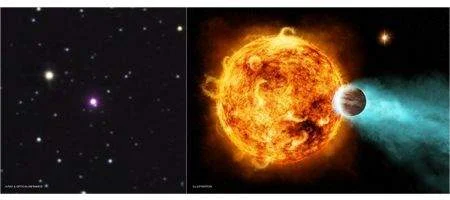Astronomers at the Chandra X-ray observatory say they’ve observed a planet so close to an active star that it’s evaporating.

The distance between CoRoT-2a and its planet is only about three percent of the distance between the Earth and the sun.
The star is blasting the planet with X-rays 100,000 times more intense than those the Earth receives from the sun – and data from Chandra suggests that the high-energy radiation is evaporating about five million tons of matter from the planet every second.
The observations show that CoRoT-2a is a very active star, with bright X-ray emission produced by powerful, turbulent magnetic fields.
Usually, stars of this age are rather less busy. It’s possible, says the team, that the activity may be caused by the planet’s proximity. The planet may be speeding up the star’s rotation, causing its magnetic fields to remain active longer than expected.
This idea’s backed up by observations of a likely companion star to CoRoT-2a that orbits at a distance about a thousand times greater than the distance between the Earth and the sun. This star isn’t detected in X-rays, perhaps because it does not have a nearby planet like CoRoT-2b to cause it to stay active.
CoRoT-2b, was discovered by the French Space Agency’s Convection, Rotation and planetary Transits, or CoRoT, satellite in 2008. It’s located about 880 light years from Earth and has a mass about three times that of Jupiter.






